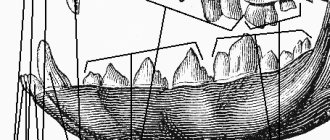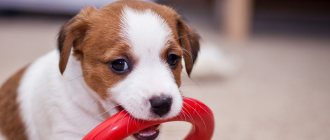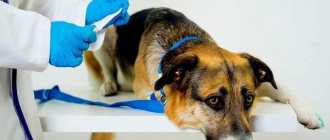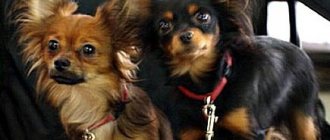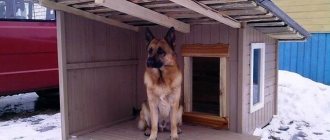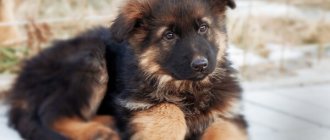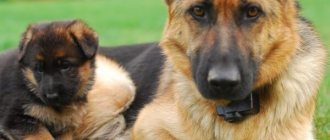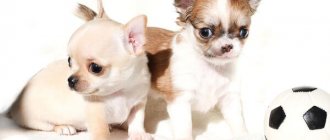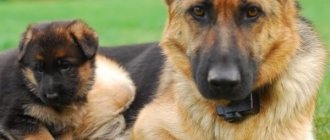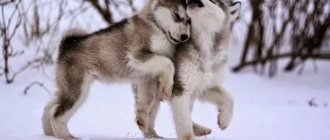The change of teeth in a German Shepherd begins in the midst of a period of active growth. From 14 weeks of age, the puppy quickly (mostly in leaps and bounds) increases in size. His muscular skeleton is formed, his paws grow, his chest bones and skull bones grow.
Small, fragile puppy teeth are replaced by impressive, strong fangs. This stage usually ends simultaneously with the appearance of a full set of molars. The dog's further development occurs at a slower pace.
Jaw structure, shepherd bite
There are 42 permanent teeth in a dog's mouth (20 in the upper jaw and 22 in the lower jaw) . The teeth, with the exception of molars (permanent molars), are evenly distributed: on both jaws there are 2 canines, 6 incisors and 8 premolars (false-rooted teeth). The difference is observed only in the number of molars - there are 6 on the bottom, while on the top there are only 4.
Important! Experienced dog handlers know that it is forgivable for a show dog to be missing one of the premolars, but no other tooth.
The form of closure of the jaws/teeth is called a bite, and in a German Shepherd it is always scissor-shaped - the incisors of the upper jaw fit tightly onto the incisors of the lower jaw, reminiscent of the convergence of the cutting blades of scissors. Between the cutters, which should not touch each other, a gap of no more than 1–3 mm is allowed.
Return to content
German Shepherd body.
The topline is solid, stretches from the base of the neck, through the well-defined withers and back, set very slightly in an inclined position towards the horizon, gradually turning into a sloping croup.
The back is strong, strong, and muscular. The loin is short, well developed and muscular. The croup should be long, slightly sloping (about 23 degrees to the horizontal) and blend invisibly into the base of the tail. Not hunchbacked, not sagging. A dog with an irregular topline
When does teeth change start?
Shepherd puppies, toothless from birth, by the age of 1.5 months acquire a full set of baby teeth (28) of incisors, canines and premolars, and by 2 months they already demonstrate a typical scissor bite. Chewing teeth erupt no earlier than six months: if molars appeared at the same time as milk teeth, it means that they will no longer be replaced by molars. Such animals are removed from the breeding program.
Important! The number “28” is not a constant - there may be a little more or less temporary teeth (after changing teeth, the dog usually restores its standard dental formula).
The change of teeth in a German Shepherd, with the gradual dissolution of dental roots and the germination of permanent teeth, begins at 3.5–4 months. Fangs and incisors are loosely held in the jaws, stagger and fall out, and the immune system weakens.
Signs of tooth change:
- increase in body temperature by 0.1°–0.3°;
- itching in the gums (puppy chews furniture/shoes);
- lethargy, less activity;
- drooping ears;
- intestinal disorders (loss of appetite).
The last symptom is not always associated with changing teeth - it often signals an infection, which is why it is better to show the puppy to a doctor.
Return to content
Signs of change
Temporary teeth do not have roots, for this reason they serve for a short time, being replaced by molars. Milk teeth are small, thin, like needles. At first they grow tightly, but as the jaw grows, the distance gradually increases.
By the age of two months, temporary ones begin to be replaced by permanent ones. For VEOs, this period is longer, since they belong to a large breed of dog. The owner often does not notice the main point in the shift, because the puppies swallow the lost teeth while eating.
Symptoms indicating a change process:
- restless behavior - the puppy rubs its face with its paws, whines;
- appetite decreases, but the baby wants to gnaw and chew everything;
- body temperature rises;
- does not allow the mouth to be examined;
- The mouth may smell unpleasant.
With normal development, the change occurs without alarming signs. The baby is constantly gnawing on something, is energetic and cheerful.
Do I need to adjust my diet?
Often the cause of malocclusion is precisely feeding errors. Experts are convinced that food rich in minerals/vitamins (during the period of teeth change) is capable of correcting a malocclusion in 50% of cases, and the final conclusion about underbite or overbite is made after all teeth have been replaced.
Puppies receiving natural food or economy food are given mineral supplements with calcium, fluorine and phosphorus. A lack of calcium (as well as its excess) can provoke allergic manifestations or cause diseases of the musculoskeletal system. German Shepherds that eat dry diets labeled “holistic” and “super-premium” do not need such bait.
Important! Veterinarians mention another key factor that leads not only to all sorts of problems with changing teeth, but also to other deviations and even diseases of the dental system - this is a reduction in feeding time.
If previously at least 20–30 minutes were allotted for eating, now this interval has narrowed to 5–10 minutes, which significantly reduces the load on the dentofacial apparatus. In addition, dog breeders should remember that when changing teeth, the puppy is given large teeth that promote the growth, straightening and strengthening of permanent teeth.
Return to content
Preventing dental problems
Not only molars, but also baby teeth need care. To keep them healthy, they are cleaned once a week with a brush and veterinary paste, which dissolves plaque and deposits:
- squeeze the paste onto the brush in the amount specified in the instructions;
- gently part the lips of the German Shepherd;
- Clean in a circular motion without pressing too hard on the brush.
If necessary, wash off the paste - the rules for use differ depending on the brand of the product.
There are opponents of this procedure. In their opinion, in the wild no one brushes the teeth of animals, so domestic dogs do not need it either. But it should be borne in mind that many owners feed their pets food that does not contain enough mineral elements.
Also, not every dog will chew vegetables on its own. Therefore, cleaning is not a whim, but a necessity.
Important. If tartar appears, you should contact a veterinarian. A specialist will remove it mechanically or using an ultrasonic device.
A German Shepherd can clean its mouth on its own by chewing dental treats. They easily remove plaque that has not yet hardened. However, they should not be given too often, as this leads to rapid wear of the canines and incisors.
If the German Shepherd has good heredity, and the owner properly cares for the puppy, the change of teeth will take place without any problems. Otherwise, you will need the help of a veterinarian. By letting things take their course, the owner puts the pet’s health at risk.
Observation, care, help for the puppy
General recommendations when changing teeth in a German Shepherd:
- reduce the time allocated for walking/training;
- protect the puppy from unnecessary physical activity;
- exclude games of tug of war.
When your pet's permanent fangs erupt, you can inadvertently dislodge a growing tooth and ruin your bite: it is better to seek the help of a doctor or an experienced dog handler. Often, a baby tooth is removed quite easily by pressing outward from the jaw—it is enough to lightly rock it several times a day with a finger wrapped in a sterile bandage. This is done carefully, in a playful way, so that the puppy does not develop a defensive reflex.
The least problematic are small premolars, which are removed with gentle pressure in an outward direction. The most difficult ones are single-rooted, deep-set canines. True, their displacement is rarely observed, since the permanent fangs are extremely strong and usually do not allow themselves to be pushed aside. Double fangs do occur and look unsightly, so it is necessary to remove the retained primary fang without damaging the permanent one.
Return to content
How to help a dog
Helping a German Shepherd puppy during teething includes:
- in reducing the duration of walking and training sessions;
- reducing physical activity;
- excluding games with dragging objects.
It is useful to rock a loose baby tooth with a finger wrapped in a sterile bandage. The process is turned into a game so that the puppy does not develop negative associations.
The tooth is pulled out when it is separated from the gum without effort, and it must be pulled not upward, but to the side. If it wobbles, but still sits confidently in place, it is better not to touch it. There is a high risk of breaking off a piece that will remain in the jaw. Then you will have to resort to surgery.
You can buy a special teether for your German Shepherd puppy. This is a hollow toy made of durable plastic and filled with water. It is kept in the refrigerator and then given to the dog. With its help, the animal will get rid of itching in the gums and pain.
Important. When teeth are actively changing (from 3 to 6 months), the puppy cannot be vaccinated. Due to a weakened immune system, a German Shepherd may become ill with the disease for which it is vaccinated.
Irregular teeth in a shepherd dog
Abnormal “rotation” of teeth occurs not only due to dietary errors, but also due to genetic abnormalities . The planned change of teeth in a German Shepherd begins at 4 months (with the disappearance of the primary incisors) and ends at six months.
Important! Sometimes they talk about the absence of roots in baby teeth, but how would they then stay in the jaws? In reality, the roots of temporary teeth become the material for the formation of permanent teeth.
In rare cases, the root will not dissolve, in which case your veterinarian will show it to you after removal. Inadequacies in feeding/maintenance and breed predisposition are increasingly leading to irregular teeth and a number of dental diseases. According to some dog handlers, an uneven row of teeth on a shepherd dog is an unflattering characteristic of its owner. This statement is not always true, but there is some truth in it.
Late shift
So, at 6 months all permanent teeth should have erupted, but this does not always happen. Sometimes, when changing teeth in a German Shepherd, for some reason one of the permanent ones is delayed: such a tooth can be felt in the gum, but does not come to the surface.
Doctors do not recommend cutting the skin (the wound will quickly heal), but they suggest gently etching it with a stick purchased at the pharmacy. This is a painless procedure that stimulates tooth germination within a few days. It is much worse if the gum is empty and nothing can be felt inside - the tooth will no longer appear in this place.
The owner may encounter a similar problem when a shepherd’s baby tooth does not fall out (persists) and a permanent one does not form. This usually occurs with the incisors (P2 and P3), whose roots do not dissolve, preventing the permanent teeth from emerging.
This is interesting! A persistent baby tooth can last up to 2–3 years. During this time, the shepherd undergoes grading and participates in exhibitions, appearing as an animal with a full set of teeth.
This lasts exactly until the baby tooth falls out, which the owner learns about from an expert when he comes to the next exhibition. Moreover, the owner of a shepherd dog will not always understand the reasons for the lost tooth and will believe that it fell out due to injury. Of course, a dog can break, but not pull out a tooth by the roots, which means that we are talking about the loss of a persistent milk tooth.
Growth disorders
According to the observations of dog handlers, recently many medium-sized breeds, including the German Shepherd, have been showing deviations when changing teeth. Replacing baby teeth with permanent ones is often accompanied by growth disorders such as:
- complete retention of primary teeth (more common in toy breeds) is a rare anomaly with preservation of all primary teeth and simultaneous eruption of permanent teeth. There is a double row of teeth (canines, incisors and premolars) and false polyodontia;
- incomplete (partial) retention of primary teeth is the most common disorder, more typical for canines/incisors. False polyodontia is observed in certain groups of teeth;
- temporary delay in the change of teeth - milk teeth (mostly canines and less often incisors) fall out by about 1–1.5 years;
- permanent delay in tooth change (diagnosed mainly in small breeds) – milk teeth, mostly canines, remain throughout the dog’s life.
This is interesting! The clinical picture of false polyodontia (when the milk teeth have not fallen out, but the permanent ones have already erupted) looks like this: up to 50-60 teeth “sit” in the oral cavity of a German shepherd at the same time.
And since the teeth (molars/deciduous teeth) cannot fit in one row, polyodontia is complemented by dystopia, when the tooth moves forward or backward. Both baby and molar teeth can be in an incorrect position.
Return to content
Chest BUT.
“Moderately wide, the chest bone is as long as possible, the lower part of the chest is well developed. The depth of the chest (from the withers to the elbow perpendicular to the ground) should be 45-48% of the height at the withers. Barrel-shaped or too flat ribs are a defect.”
The German Shepherd is a working dog, therefore, for it, the structure of the body is one of the main breed characteristics, on which its working productivity directly depends. The body serves to attach the animal’s locomotor system, to transmit the impulse that occurs when pushing the hind limbs to the front of the body, to maintain balance during movement. And, of course, all the vital organs and tissues are located in the chest, which is part of the dog’s body system.
A properly built German Shepherd's body should give the impression of integrity and completeness. The top line formed by the spine should be a straight line, as if drawn with a single stroke of a pen, smoothly falling from the well-defined withers to the root of the tail. The horizontal proportions of the body play an extremely important role, i.e. the optimal ratio of the thoracic (50%), lumbar (25%) and sacral (25%) parts of the spine, ensuring the harmony and strength of the German Shepherd's build and the balance of its movements.
Returning to the conversation about the stretched body, which is defined by the breed standard, we should dwell on the concept of compactness, which is sometimes confused with the concept of a shortened format. Paradoxical as it may seem at first glance, a German Shepherd should have a compact body with an overall elongated format.
It should be noted that most of the modern German Shepherd population does not have significant problems in the structure of the body. The only exception is, perhaps, the length of the croup, which leaves much to be desired in a significant part of the livestock. Sometimes there are dogs with a shortened chest and a stretched loin.
Nice German Shepherd chest of correct depth.
Flat rib dog.
German Shepherd tail.
The tail reaches at least to the hock joint, but not further than the middle of the metatarsus. On its underside the coat is slightly longer and the tail is carried hanging down in a gentle curve. When the dog is excited or in motion, the tail is raised and held above, but not above, the horizontal line (the dog's topline).
Surgical correction of the tail is prohibited.
In addition to the fact that a dog’s tail is an important breed characteristic and acts as a kind of balancer, facilitating body control during movement and turns, it also to some extent serves as an indicator of the animal’s health.
There is a problem in the German Shepherd that many breeders do not pay due attention to, partly due to ignorance, partly because this defect in adult dogs is hidden behind the abundant hair on the tail. We are talking about the so-called “kink” of the tail - a genetically determined pathology of the caudal spine, manifested in changes in shape, varying degrees of thickening and improper fusion of individual caudal vertebrae. Unfortunately, the German Shepherd standard does not say anything about this, but according to the latest scientific data, this pathology in dogs is genetically associated with disturbances in psychomotor functions, changes in other parts of the spine and, possibly, even the spinal cord.
The correct position and correct shape of the tail of the German Shepherd.
Incorrect position and shape of the tail of a German Shepherd.
Tail crease.
Front limbs of a German Shepherd.
When viewed from all sides, the forelegs are straight and when viewed from the front, absolutely parallel. The shoulder blades and shoulder blades are equal in length, muscular and firmly attached to the body. The angle between the shoulder blade and the humerus is ideally 90 degrees, but up to 110 degrees is acceptable. The elbows should not be tucked in or turned out, either at rest or in motion. When viewed from all sides, the forearms are straight and absolutely parallel to each other, dry and muscular. The metacarpus is approximately 1/3 the length of the forearm, and is located at an angle of 20–22 degrees in relation to it. Weak pasterns (at an angle of more than 22 degrees) or steep pasterns (at an angle of less than 20 degrees) affect the dog's working ability, especially its endurance. The front feet are round, balled, with arched toes, the pads are strong, not cracked; claws are strong, dark in color. The forelimbs serve to support the body and cushion the body during movement. They take on the entire weight of the body when it comes into contact with the ground, and the faster the dog moves, the greater the load on them. In a correctly built German Shepherd, the forelimbs have only a supporting function and do not take part in pushing. They do not have a bone attachment to the body, this connection is carried out with the help of muscles, so the front part of the body must be equipped with well-developed, prominent muscles and elastic, elastic ligaments. An article about training a dog to develop muscle mass.
The shoulder blade plays a key role in distributing balance during movement. Its length, width and inclined position (45° to the horizon) provide the high anteriority characteristic of the breed (when it seems that the rear part of the body is planted, this is due to the high anteriority). The humerus should also be long, equal in length to the shoulder blade, and ensure that the forelimbs are positioned strictly under the withers. The maintenance of high forward position and the length of the stride of the forelimbs also depend on its length.
Strength, parallelism of posture and straightness of movement of the limbs in German terminology is called “korrekte Front” (correct front).
In German Shepherd breeding, the shoulder girdle has always been the weakest link. To this day, obtaining animals with an ideal structure of the scapulohumeral joint is considered a great success for breeders. The most common problems are insufficient length and slope of the scapula, and as a result, a more “open” angle between the scapula and the humerus, limiting the stride width of the forelimbs.
Movements of a German Shepherd with normal limb structure.
Incorrect structure of the forelimbs (size).
Possible complications, prevention
Any surprises when changing teeth in a German Shepherd may be due to genetic predisposition, calcium and phosphorus deficiency, previous disease, as well as weak chewing muscles.
If the chewing apparatus is not formed correctly, the shepherd dog will receive not only crooked teeth and bite deformation (underbite or overbite), but also:
- early destruction of enamel;
- formation of tartar;
- carious lesions and other ailments.
During the period when a German Shepherd puppy's teeth are changing, the owner is obliged to examine his mouth regularly so as not to miss any emerging anomalies and to react without delay.
This is interesting! The teeth of a German Shepherd are its formidable weapon and a source of pride for its owner. When biting, the jaws compress with a force of 100 kg/sq. see, and in this indicator not many dogs compete with the shepherd.
Strong, healthy teeth help you win in the ring and show better performance. Dog teeth should be protected from puppyhood, never using stones or other excessively hard attributes for fetch. To strengthen the gums, the pet is given large bones, dog crackers, apples and carrots. Once a week, the shepherd dog needs to brush its teeth, for which you will need a children's toothbrush (with half-cut bristles) and toothpaste that does not form a lot of foam and dissolves plaque. For any dental problems, you should go to the doctor, be it tartar, gum inflammation or a broken tooth fragment.
Return to content
Difficulties
The main problems that owners may encounter during this period include:
Slowing down the process
The cause may be poor development of the chewing muscles, a lack of calcium and phosphorus in the body, a previous disease or a genetic predisposition.
Two fangs
At the same time, 2 fangs will grow in one place - permanent and milk. This happens because the tooth root is not dissolved in time. In such cases, it is necessary to contact a veterinarian as soon as possible and remove the interfering tooth. It is not recommended to do this yourself. The undissolved root is quite large and there is a possibility that the intervention of an amateur will only worsen the situation. After which a full-fledged surgical operation will be required. In order to correct the problem in time and take action, you need to regularly examine the mouth while the puppy is changing teeth.
Two fangs
When to contact a veterinarian
People go to the clinic for any problems with the change of teeth in a German Shepherd, when there is no confidence in their own abilities, experience and knowledge. If polyodontia is noted, the dentist will remove baby teeth, following certain rules:
- Only those milk teeth will be removed where the crown of the molar has appeared (usually after the removal of a temporary tooth, the permanent one takes its place);
- baby teeth are pulled out until the shepherd dog is 9 months old. In older animals, the occlusion altered by polyodontia is no longer restored;
- a tooth that splits during surgery is removed with roots and fragments;
- The removal of a baby tooth is completed by polishing the permanent one growing nearby, if plaque/tartar is found on it.
Important! When removing a baby tooth, there is a possibility of damaging the molar bud (if it has not yet erupted by this time), which can stop the growth of a permanent tooth in principle.
Surgical intervention is also indicated for hypodontia - the doctor makes an incision in the gum and periosteum to allow permanent teeth to emerge. Before the operation, an x-ray examination is prescribed to establish the position/condition of the permanent tooth germ.
Surgical manipulations in the dog’s oral cavity are performed using general/local anesthesia, as well as using sedatives. Of course, painkillers have a negative effect on the dog’s body, but you cannot do without them when cutting the periosteum or removing teeth. Anesthesia protects the animal from pain and allows you to undergo the operation without stress.
Return to content
At what age do teeth change?
The change of teeth in German Shepherd puppies occurs at 3-4 months. The exact timing depends on the individual characteristics of the baby. For some dogs this period begins a little later, for others a little earlier.
The rudiments of molars develop under the milk teeth. They rush to the surface, shaking and gradually “squeezing out” their predecessors.
First, the incisors change - from 3 to 5 months. From 5 to 7 months, fangs erupt. At the same time, the molars appear. The last to appear are the premolars, at 6-8 months.
The change is completed at approximately 9 months.
Important. If the puppy is 9 months old and the shift is still ongoing, you should take your German Shepherd to the veterinarian. Perhaps the dog has a pathology that requires medical intervention.
Dog's dental system
For any breed of dog, the dental system plays an extremely important role in the body, since the quality of life and health of the pet depends on it. These are very durable bone tissue formations that perform important functions:
- attacks;
- protection;
- capture;
- retention;
- tearing and crushing food;
- killing prey.
The dental chart is written with a special formula, which indicates the number of dental units of an adult animal on one half of each jaw.
On the top there is:
- 3 incisors;
- 1 fang;
- 4 premolars;
- 2 molars.
- 3 incisors;
- 1 fang;
- 4 premolars;
- 3 molars.
The dental formula is written in alphabetic and numerical combinations, describing the location of the teeth in the animal’s mouth. The tooth consists of an upper crown that stands out above the gum. Its slightly narrowed neck is tightly covered by the gum. The dental root hidden in the alveolus has a small hole in the upper part leading into the cavity of the dental unit. Inside it is a soft pulp in which blood vessels and nerves are located. The main part consists of dentin. The outside is covered with hard tooth enamel. The tooth is located on the periosteum, which is called periodontium.
Photo: wikimedia.org Dog teeth: 1, 2, 3 - incisors, 4 - canines, 5 - premolars, 6 - molars
Symptoms
You may not even notice teeth falling out; dogs usually swallow them. As a rule, owners notice problems with the oral cavity when the pathological process is already in full swing and more than one tooth is already suffering.
Since the oral cavity suffers when teeth fall out, the symptoms are always the same. But there are also distinctive features depending on the reason. Now let's take a closer look.
Symptoms of oral diseases
Determining what kind of inflammation in the mouth is possible only with a thorough examination of the oral cavity, but the signs that owners notice are common to all:
- Partial refusal to eat, eats without appetite. He may even growl while he eats (due to pain in his gums).
- Bad breath.
- Bleeding from the mouth may be observed while eating.
- Profuse drooling.
- Swelling of the mouth (in some cases it is not observed, but in others the swelling extends to the muzzle).
Usually, only after the above symptoms, the owners look into the dog’s mouth, and then they notice that its teeth are falling out. In addition, you can see accompanying symptoms:
- Swelling and redness of the gums.
- Exposed tooth roots.
- Blueness between teeth.
- Ulcers on the gums.
- With pulpitis, you may notice that the color of the diseased tooth is different from the rest (dull, grayish, sometimes pinkish).
If teeth fall out due to metabolic disorders, then the initial symptoms look a little different:
- The quality of wool deteriorates.
- In young dogs, bone growth is impaired.
- Weight loss.
- Lethargy.
And soon after this, either inflammation of the oral cavity appears, or the quality and strength of the teeth themselves deteriorate. As a result, we see lost teeth.
In cases where the cause of lost teeth is a pathology in the development of the jaw, then everything is clearly visible.
Number of teeth by breed
The number of teeth may vary between breeds. Large dogs such as Labrador, German Shepherd or Rottweiler should have 42 teeth in their mouth. Deviation from standards is considered a vice.
In medium and small breeds, the number of teeth can range from 36 to 40. Sometimes there are individuals with 42 teeth in the mouth among spaniels and dachshunds, which are among the most common representatives of medium and small dogs. It will not be possible to find a terrier with so many teeth due to the fact that as a result of the selection of this breed, the structure of the jaws of such a dog has significantly changed, as a result of which the intercanine space has narrowed.
Types of bite
The following types are distinguished:
- bulldog (also called undershot);
- undershot;
- normal (or scissor);
- straight (pincer-shaped).
The standards for each variety vary widely, and what is common in breeds like the Pekingese is considered pathological in other species.
bulldog
This overbite is typical in Bull Terriers and Bulldogs, as the name suggests, but is also normal in Pekingese and related breeds.
The structure of the oral cavity is characterized by excessive development of the lower jaw, which protrudes forward. The canines are often exposed with this structure.
Underbite
This type of bite results in insufficient development of the lower jaw, resulting in a large gap remaining between the upper and lower incisors.
This type causes the most problems, as it provokes a number of dental pathologies.
In particular, the most common problem with underbite is the formation of tartar.
Normal
This structure of teeth is determined historically. The ancestors of modern domesticated dogs were forced to get their food by hunting, and for this they had to not only track and overtake prey, but also hold it. This explains the scissor bite.
With this structure, the incisors of the lower jaw are closely adjacent to the back of the upper ones, as a result of which a kind of “lock” is formed. A normal bite is typical for Dobermans.
Among all the varieties, it is recognized as the most “non-problematic”, since the owners of these breeds rarely seek medical help for their pets during the period of tooth loss.
Straight
This type of overbite is unacceptable for most breeds and is considered a serious defect at shows. With a pincer-like arrangement of teeth, the incisors of the upper and lower jaws are located on the same line, as a result of which their ends quickly grind down from pressure on each other.
With this type of bite, molars and canines develop without pathologies.
Expert opinion
Anna Abramenko
An avid dog lover. Experience in veterinary medicine since 2009.
Ask a Question
A pincer-like structure of teeth is normal if it is genetically determined, but it often happens that dog owners themselves develop a straight bite - this happens due to frequent games of tugging with objects.
